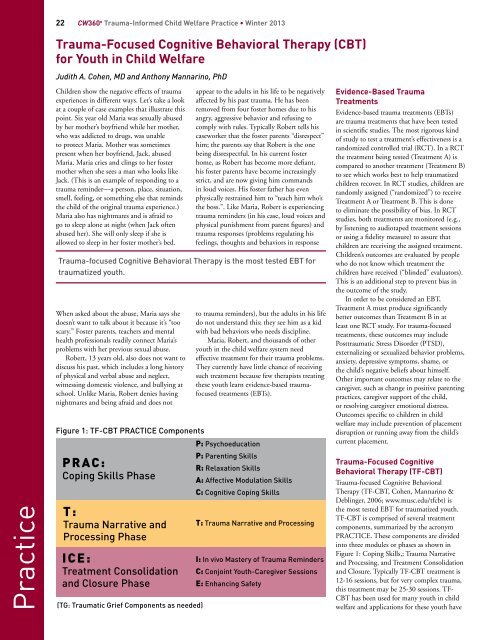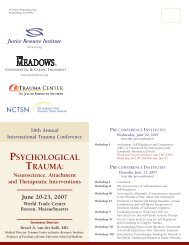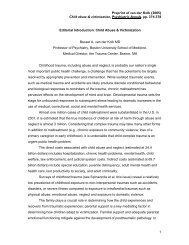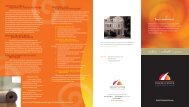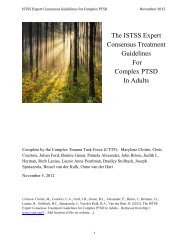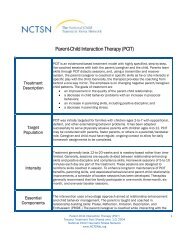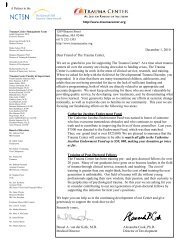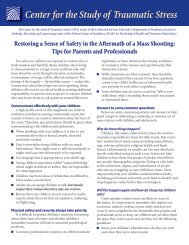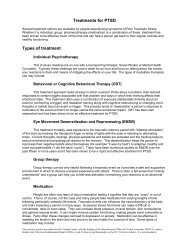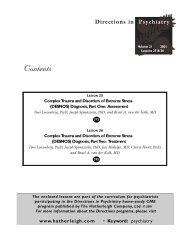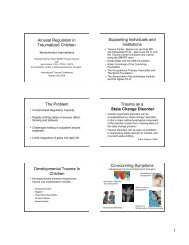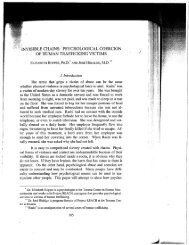in Child Welfare - The Trauma Center
in Child Welfare - The Trauma Center
in Child Welfare - The Trauma Center
You also want an ePaper? Increase the reach of your titles
YUMPU automatically turns print PDFs into web optimized ePapers that Google loves.
22 CW360 o <strong>Trauma</strong>-Informed <strong>Child</strong> <strong>Welfare</strong> Practice • W<strong>in</strong>ter 2013<strong>Trauma</strong>-Focused Cognitive Behavioral <strong>The</strong>rapy (CBT)for Youth <strong>in</strong> <strong>Child</strong> <strong>Welfare</strong>Judith A. Cohen, MD and Anthony Mannar<strong>in</strong>o, PhDPractice<strong>Child</strong>ren show the negative effects of traumaexperiences <strong>in</strong> different ways. Let’s take a lookat a couple of case examples that illustrate thispo<strong>in</strong>t. Six year old Maria was sexually abusedby her mother’s boyfriend while her mother,who was addicted to drugs, was unableto protect Maria. Mother was sometimespresent when her boyfriend, Jack, abusedMaria. Maria cries and cl<strong>in</strong>gs to her fostermother when she sees a man who looks likeJack. (This is an example of respond<strong>in</strong>g to atrauma rem<strong>in</strong>der—a person, place, situation,smell, feel<strong>in</strong>g, or someth<strong>in</strong>g else that rem<strong>in</strong>dsthe child of the orig<strong>in</strong>al trauma experience.)Maria also has nightmares and is afraid togo to sleep alone at night (when Jack oftenabused her). She will only sleep if she isallowed to sleep <strong>in</strong> her foster mother’s bed.When asked about the abuse, Maria says shedoesn’t want to talk about it because it’s “tooscary.” Foster parents, teachers and mentalhealth professionals readily connect Maria’sproblems with her previous sexual abuse.Robert, 13 years old, also does not want todiscuss his past, which <strong>in</strong>cludes a long historyof physical and verbal abuse and neglect,witness<strong>in</strong>g domestic violence, and bully<strong>in</strong>g atschool. Unlike Maria, Robert denies hav<strong>in</strong>gnightmares and be<strong>in</strong>g afraid and does notappear to the adults <strong>in</strong> his life to be negativelyaffected by his past trauma. He has beenremoved from four foster homes due to hisangry, aggressive behavior and refus<strong>in</strong>g tocomply with rules. Typically Robert tells hiscaseworker that the foster parents “disrespect”him; the parents say that Robert is the onebe<strong>in</strong>g disrespectful. In his current fosterhome, as Robert has become more defiant,his foster parents have become <strong>in</strong>creas<strong>in</strong>glystrict, and are now giv<strong>in</strong>g him commands<strong>in</strong> loud voices. His foster father has evenphysically restra<strong>in</strong>ed him to “teach him who’sthe boss.”. Like Maria, Robert is experienc<strong>in</strong>gtrauma rem<strong>in</strong>ders (<strong>in</strong> his case, loud voices andphysical punishment from parent figures) andtrauma responses (problems regulat<strong>in</strong>g hisfeel<strong>in</strong>gs, thoughts and behaviors <strong>in</strong> response<strong>Trauma</strong>-focused Cognitive Behavioral <strong>The</strong>rapy is the most tested EBT fortraumatized youth.to trauma rem<strong>in</strong>ders), but the adults <strong>in</strong> his lifedo not understand this; they see him as a kidwith bad behaviors who needs discipl<strong>in</strong>e.Maria, Robert, and thousands of otheryouth <strong>in</strong> the child welfare system needeffective treatment for their trauma problems.<strong>The</strong>y currently have little chance of receiv<strong>in</strong>gsuch treatment because few therapists treat<strong>in</strong>gthese youth learn evidence-based traumafocusedtreatments (EBTs).Figure 1: TF-CBT PRACTICE ComponentsP: PsychoeducationP: Parent<strong>in</strong>g SkillsPRAC:R: Relaxation SkillsCop<strong>in</strong>g Skills PhaseA: Affective Modulation SkillsC: Cognitive Cop<strong>in</strong>g SkillsT:<strong>Trauma</strong> Narrative andProcess<strong>in</strong>g PhaseICE:Treatment Consolidationand Closure Phase(TG: <strong>Trauma</strong>tic Grief Components as needed)T: <strong>Trauma</strong> Narrative and Process<strong>in</strong>gI: In vivo Mastery of <strong>Trauma</strong> Rem<strong>in</strong>dersC: Conjo<strong>in</strong>t Youth-Caregiver SessionsE: Enhanc<strong>in</strong>g SafetyEvidence-Based <strong>Trauma</strong>TreatmentsEvidence-based trauma treatments (EBTs)are trauma treatments that have been tested<strong>in</strong> scientific studies. <strong>The</strong> most rigorous k<strong>in</strong>dof study to test a treatment’s effectiveness is arandomized controlled trial (RCT). In a RCTthe treatment be<strong>in</strong>g tested (Treatment A) iscompared to another treatment (Treatment B)to see which works best to help traumatizedchildren recover. In RCT studies, children arerandomly assigned (“randomized”) to receiveTreatment A or Treatment B. This is doneto elim<strong>in</strong>ate the possibility of bias. In RCTstudies, both treatments are monitored (e.g.,by listen<strong>in</strong>g to audiotaped treatment sessionsor us<strong>in</strong>g a fidelity measure) to assure thatchildren are receiv<strong>in</strong>g the assigned treatment.<strong>Child</strong>ren’s outcomes are evaluated by peoplewho do not know which treatment thechildren have received (“bl<strong>in</strong>ded” evaluators).This is an additional step to prevent bias <strong>in</strong>the outcome of the study.In order to be considered an EBT,Treatment A must produce significantlybetter outcomes than Treatment B <strong>in</strong> atleast one RCT study. For trauma-focusedtreatments, these outcomes may <strong>in</strong>cludePosttraumatic Stress Disorder (PTSD),externaliz<strong>in</strong>g or sexualized behavior problems,anxiety, depressive symptoms, shame, orthe child’s negative beliefs about himself.Other important outcomes may relate to thecaregiver, such as change <strong>in</strong> positive parent<strong>in</strong>gpractices, caregiver support of the child,or resolv<strong>in</strong>g caregiver emotional distress.Outcomes specific to children <strong>in</strong> childwelfare may <strong>in</strong>clude prevention of placementdisruption or runn<strong>in</strong>g away from the child’scurrent placement.<strong>Trauma</strong>-Focused CognitiveBehavioral <strong>The</strong>rapy (TF-CBT)<strong>Trauma</strong>-focused Cognitive Behavioral<strong>The</strong>rapy (TF-CBT, Cohen, Mannar<strong>in</strong>o &Debl<strong>in</strong>ger, 2006; www.musc.edu/tfcbt) isthe most tested EBT for traumatized youth.TF-CBT is comprised of several treatmentcomponents, summarized by the acronymPRACTICE. <strong>The</strong>se components are divided<strong>in</strong>to three modules or phases as shown <strong>in</strong>Figure 1: Cop<strong>in</strong>g Skills,; <strong>Trauma</strong> Narrativeand Process<strong>in</strong>g, and Treatment Consolidationand Closure. Typically TF-CBT treatment is12-16 sessions, but for very complex trauma,this treatment may be 25-30 sessions. TF-CBT has been used for many youth <strong>in</strong> childwelfare and applications for these youth have


